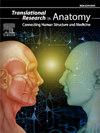在线教育模块对健康专业人员学习肌肉骨骼解剖学的影响。系统回顾
Q3 Medicine
引用次数: 0
摘要
肌肉骨骼(MSK)解剖学是各种医疗保健学科临床实践的基础,包括医学、物理治疗和骨科。技术的进步导致人们越来越关注在线学习工具,为传统教学方法提供了替代方案。目的本系统综述评估在线学习(e-learning)模块对卫生专业人员肌肉骨骼解剖学教育的影响。方法在Scopus、PubMed、Cochrane、Web of Science、CINAHL进行综合检索。入选标准包括使用在线学习干预手段(如视频讲座、3D模型和虚拟实验室)进行解剖学教育的卫生专业人员和学生。通过JBI检查表对研究的偏倚风险进行评估。结果947份记录中,18项研究被纳入本综述。本综述包括8项准实验、7项横断面、1项病例对照和2项随机对照试验(rct)。总共78%的研究纳入了多种在线干预措施,如视频教程、交互式3D模型和虚拟实验室。此外,67%的研究表明,学习者更喜欢在线和面对面教学相结合的混合模式,因为与传统方法相比,这种模式在提高解剖学知识和肌肉骨骼能力方面显著增强了学习体验。包含实践元素的模块显著提高了学习者处理肌肉骨骼案例的信心。疫情加速了在线解剖学教育的普及,许多研究表明,数字平台成功地取代了传统方法,同时取得了相当的教育成果。结论在线教学模块为传统的解剖学教学方法提供了一种有益的选择,特别是在使用交互式和混合模式时。他们提高了MSK知识的保留,临床技能和学习者满意度。未来的研究应着眼于优化这些技术,将理论知识与临床实践和患者教育相结合。本文章由计算机程序翻译,如有差异,请以英文原文为准。
The impact of online educational modules on learning musculoskeletal anatomy for health professionals. A systematic review
Background
Musculoskeletal (MSK) anatomy is fundamental to clinical practice in various healthcare disciplines, including medicine, physiotherapy, and orthopedics. Advancements in technology have led to an increased focus on online learning tools, providing alternatives to traditional teaching methods.
Objective
This systematic review assesses the impact of online learning (e-learning) modules on musculoskeletal anatomy education among health professionals.
Methods
A comprehensive search was conducted across Scopus, PubMed, Cochrane, Web of Science, and CINAHL. The eligibility criteria included studies involving health professionals and students in anatomy education using online learning interventions such as video lectures, 3D models, and virtual labs. The risk of bias of the studies was evaluated via the JBI Checklist.
Results
Out of 947 records, 18 studies were included in this review. This review included 8 quasi experimental, 7 cross-sectional, 1 case‒control, and 2 randomized controlled trials (RCTs). A total of 78 % of the studies incorporated multiple online interventions, such as video tutorials, interactive 3D models, and virtual laboratories. Additionally, 67 % of the studies indicated that learners preferred hybrid models that combined online and in-person teaching, as they significantly enhanced the learning experience compared with traditional methods in improving anatomical knowledge and musculoskeletal competency. Modules that incorporated practical elements significantly increased learners’ confidence in handling musculoskeletal cases. The pandemic accelerated the adoption of online anatomy education, with many studies demonstrating that digital platforms successfully replaced traditional methods while achieving comparable educational outcomes.
Conclusions
Online educational modules offer a beneficial alternative to traditional anatomy teaching methods, particularly when interactive and hybrid models are in use. They enhance MSK knowledge retention, clinical skills, and learner satisfaction. Future studies should aim to optimize these technologies to integrate theoretical knowledge with clinical practices and patient education.
求助全文
通过发布文献求助,成功后即可免费获取论文全文。
去求助
来源期刊

Translational Research in Anatomy
Medicine-Anatomy
CiteScore
2.90
自引率
0.00%
发文量
71
审稿时长
25 days
期刊介绍:
Translational Research in Anatomy is an international peer-reviewed and open access journal that publishes high-quality original papers. Focusing on translational research, the journal aims to disseminate the knowledge that is gained in the basic science of anatomy and to apply it to the diagnosis and treatment of human pathology in order to improve individual patient well-being. Topics published in Translational Research in Anatomy include anatomy in all of its aspects, especially those that have application to other scientific disciplines including the health sciences: • gross anatomy • neuroanatomy • histology • immunohistochemistry • comparative anatomy • embryology • molecular biology • microscopic anatomy • forensics • imaging/radiology • medical education Priority will be given to studies that clearly articulate their relevance to the broader aspects of anatomy and how they can impact patient care.Strengthening the ties between morphological research and medicine will foster collaboration between anatomists and physicians. Therefore, Translational Research in Anatomy will serve as a platform for communication and understanding between the disciplines of anatomy and medicine and will aid in the dissemination of anatomical research. The journal accepts the following article types: 1. Review articles 2. Original research papers 3. New state-of-the-art methods of research in the field of anatomy including imaging, dissection methods, medical devices and quantitation 4. Education papers (teaching technologies/methods in medical education in anatomy) 5. Commentaries 6. Letters to the Editor 7. Selected conference papers 8. Case Reports
 求助内容:
求助内容: 应助结果提醒方式:
应助结果提醒方式:


